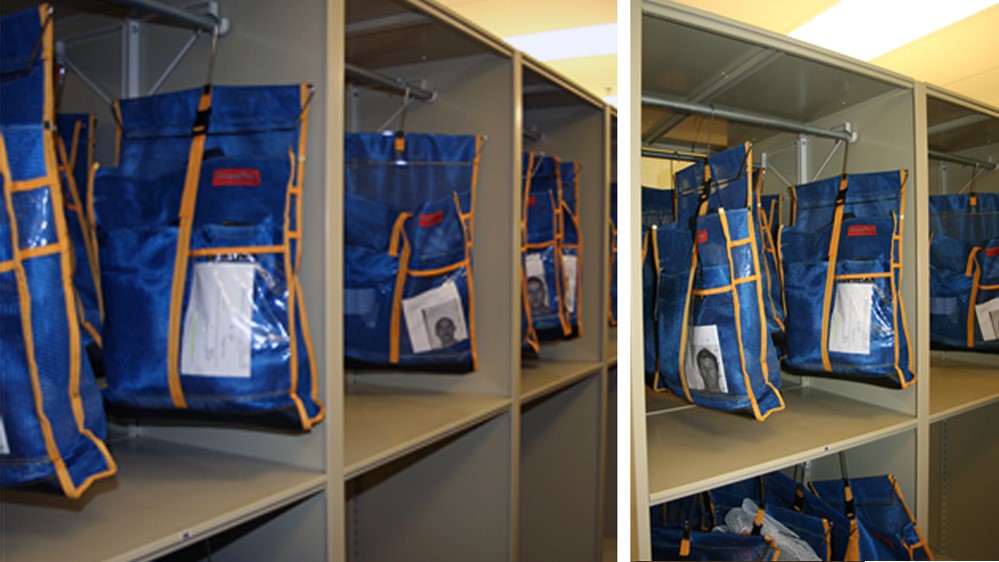CHALLENGER INSIGHTS Vol. 26:
Inmate Property Storage

Many of the storage conversations we had at the 35th Annual American Jail Association event in Austin, TX were centered on inmate property. Our only competitor at the show was White Conveyor systems, and they were promoting what I call the “dry cleaner system” — a horizontal carousel that uses hanging bags to store inmate property.
I met with an architect looking for a system to replace the vertical carousel at a jail which in his words, “didn’t want to repeat the mistake”. Similar to a dry cleaner, the system rotates to bring the requested property bag to the user. The challenge of these systems is they are not very efficient at space utilization, they can be expensive to install and maintain, they break, and when the system isn’t running, they are not efficient for finding property. The jails that have purchased the vertical carousel system buy into the concept that the system is “smart” — but sometimes the smarter solution is something much simpler.
Who doesn’t love a good storage challenge? Let’s look at a few guidelines to use in gathering information that will help you build a world class storage system.
#1 Find the right container
Inmate property is the clothing and items that the inmate has when he is booked into jail. Inmate property is often separated into property and valuables such as jewelry, wallets, and cash. The biggest challenge most departments face is what type of container to use for storing inmate property; in fact, it’s such an important topic that I’ll be writing a future Challenger Insight on the topic.
Containers can be boxes, bins, bags, and the hot trend is vacuum sealed bags. Once we know what the container is, we need to measure it and figure out the best way to store it. The best way could be an open shelf, bin dividers on a shelf, hanging racks, or some other way to store the container. Make sure you have accurate measurements, including the lid.
#2 Learn about the system
Most jails have a software system, which assigns each inmate a number. The software system is used to track information on the inmate, including medical records, court case information, home address, and a photo. We can often use this system to add a field of data for inmate property location.
#3 Learn the process
How is inmate property collected? Is the property logged and then loaded into the property container? What security is needed for the container? Yes, security is important because inmates can seek legal compensation from jails when their property is lost. Using a system with a locking mechanism or a zip tie with a serial number and having the inmate sign and record the number can help track the chain of custody for the inmate’s property.
#4 Measure the space
Measure the room and look for anything that may get in the way of a storage system such as pipes, pillars, alarms, or other obstructions. Measure the height to the sprinkler heads, and make sure you account for the location of the door and the door swing.
#5 How many containers?
Allow a buffer for inmates whose property is in transit. I recommend at least 10% extra space and containers for inmates who are being reassigned to a prison. The inmate property is usually collected by a family member, but the lag means we need to account for more than the number of beds.
 Putting together the building blocks
Putting together the building blocks
The pieces of information we gain from these survey guidelines are the building blocks for our system. I start with how many containers I can fit in one section of shelving, and divide the total number needed by the number per section to determine how many sections are needed.
As you plan the space, each aisle will have a number of property bins. I prefer to assign a number to each bin, then add that bin number to the electronic jail management system so that it corresponds to each inmate. I also prefer to have a printed copy of the record located on the property container so that it is easy to identify to whom property belongs if a container goes missing.
Adding numbers to the containers will make them easy to store and retrieve. The jail staff will learn the aisles quickly, and you can be a hero by showing the staff how to print 3 x 5 index cards on 8 ½” x 11” sheets using a word processor and the Avery templates for those types of sheets.
When jails argue that they want “smart storage,” you can show them how a simple, logical shelving system might be the smarter option after all.
